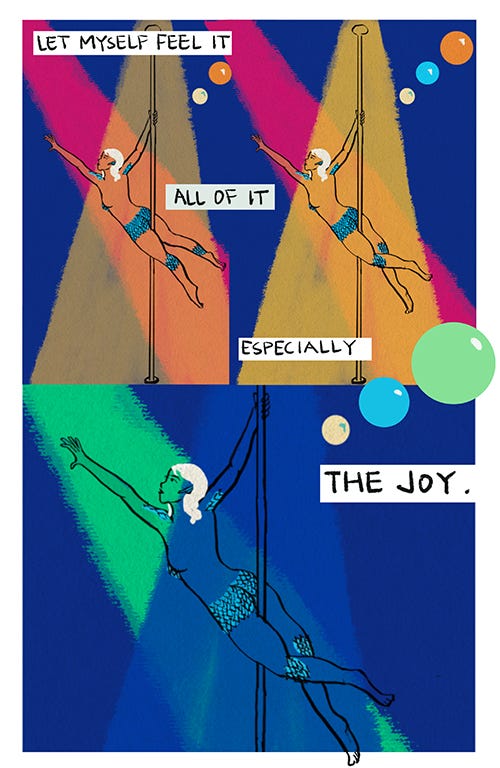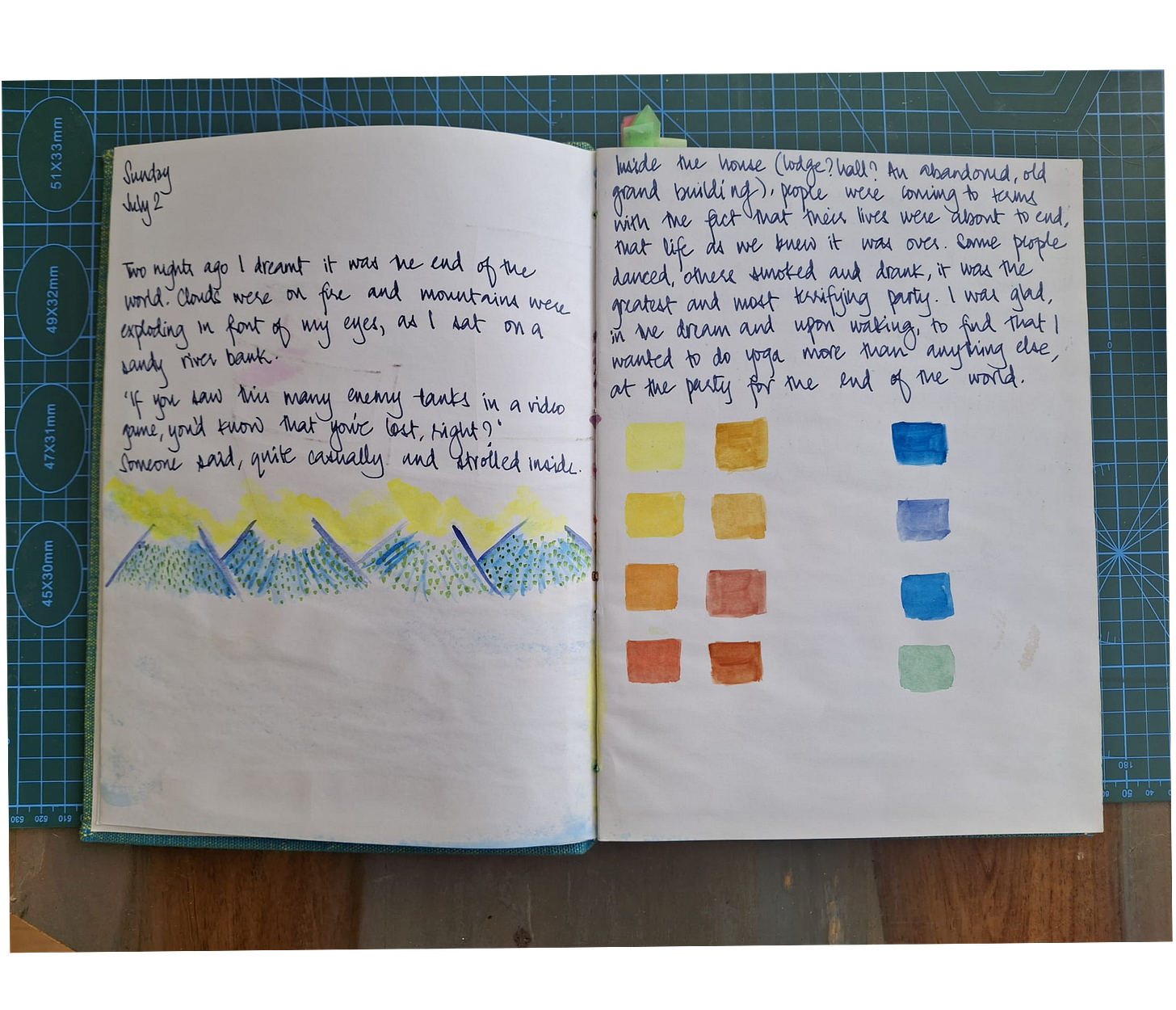The first of February is a day when thousands of illustrators spend hours drawing their day. What we see is a collection of mundane, funny and poignant moments that showcase their drawing skills. What actually happens is that their stories, told in a chorus of art, render the ordinary sublime.
If these illustrators are anything like me, they also spend the day in a spiral of self-doubt. Documenting the hours of my day as a creative freelancer feels like torture compared to the ready structure my days had when I was employed and salaried in corporate media. Everything around me has a price tag (its more than I can afford), everyone appears to have a purpose determined (and therefore validated) by a steady pay-check. There’s this quote from Annie Dillard’s The Writing Life which lives rent free in my brain:
“How we spend our days is, of course, how we spend our lives. What we do with this hour, and that one, is what we are doing. A schedule defends from chaos and whim. It is a net for catching days. It is a scaffolding on which a worker can stand and labor with both hands at sections of time. A schedule is a mock-up of reason and order—willed, faked, and so brought into being; it is a peace and a haven set into the wreck of time; it is a lifeboat on which you find yourself, decades later, still living.”
My schedule as a freelance creative involves pitching, writing, drawing, and designing. I feed my brain new technical skills, make time for rest, find new clients, seek fresh inspiration, sell my work and keep the faith (the hardest task of all). It’s a lot and it never feels like enough. I try and fail, fail and keep trying to find balance between flow and structure. To acknowledge that creativity needs seasons of rest, that being fallow is essential for a fertile creative process is to go against everything the world tells us is productive. The relentless demand for optimising every second, every hour of your day, Huberman style.
My schedule also includes a lot of movement, in fact my week is built around it — which is difficult to explain to anyone who does not understand why the body is fundamental to remembering that we are not optimisation machines. My body tells me when I’m uneasy and sore, it tells me when I need to move and when I need rest. It’s how I know when I feel shiny and well-armoured to pitch myself to new clients and when its time to batten down the hatches, tend to my wounds and draw, draw, draw.
It’s taken me years to learn to listen and to understand. Without movement, I am a shell of a person, ruminating on past hurts and future anxieties. With movement, I was able to find an antidote for the specific poison of sexual-assault trauma I endured. What my body needed after years of being frozen in fear and shame was to flow: a combination of movement-practises rooted in sensuality, playfulness and strength. I bellydance, I play capoeira and now, I’m training to be a pole dancer.
It’s possible to listen to what your body is saying without any of the acrobatics I like to subject myself to every week: take a moment, sit down, close your eyes, breathe and begin to examine the sensations you are feeling.
In your daily schedule and your hourly accounting of the self, please make some time to seek joy. It could be five minutes of dancing in the kitchen to your favourite song, playing with a pet, going for a walk and noticing something new on a familiar route. Feeling joy and experiencing wonder is a muscle, I promise if you train it, it grows stronger.
Dispatch from the Dream Journalist
Looking for respite from the #HourlyDraw, I turned to a dream journal from a long time ago. One summer morning, I woke up from a dream in which the world was ending. Clouds were on fire and mountains exploded before my eyes. I watched them from the banks of a river.
“If you saw this many enemy tanks in a video game, you’d know that you’ve lost, right?” someone next to me remarked and strolled inside.
Inside: people were coming to terms with the fact that their lives were about to end, that life as we knew it was over. Some people danced, some smoked and drank, it was the greatest and the most terrifying party.”
I felt a quiet wonder that even in this dream from years ago, I chose to move my body at the end-of-the-world panic party, and at the useful reminder that even at the end of the world, there will be humans dancing.
So here we are, together. The Doomsday Clock is now 89 seconds from midnight. The world is lurching right, and media outrage is losing its edge. How are we to dismantle the masters’ house using an internet and social media made by the masters’ very own tech-bros?
Hour by hour, day by day. Trying to make meaning. Trying to move.
Here’s some love for you in the form of ways to survive this party at the end of the world.
Walk: In the Netherlands, people have been seeking out windy exercise for more than a hundred years. Today, the practice is so common that it’s known as “uitwaaien.”
“Uitwaaien is something you do to clear your mind and feel refreshed—out with the bad air, in with the good. It’s seen as a pleasant, easy, and relaxing experience—a way to destress or escape from daily life.”
- Nautilus MagDance: (PS. If you need a playlist to feel like an exotic dancer, I got you.)
“It’s 20 strangers in a room and we play music and you’re dancing around a pole. But instead of being a five-year-old in your body, you’re now a fully embodied adult and you’re just rediscovering what play is. As adults, we’re so risk-averse. We don’t want to feel silly or stupid or embarrassed. And when you’re a kid, you don’t care about those things. There’s such a great book that I feel like really changed the way I think about my work called The Body Is Not an Apology by Sonya Renee Taylor. She talks about how we are brought up in these systems and society that instill a sense of shame around the body. So from a young age you’re apologizing for yourself or feeling shame around yourself for existing in a body that’s not white or thin or this or that and the other. Pole dancing or any movement practice instills that mind/body connection, instills play, helps you be a little less risk-averse. It’s helping you to say, I don’t need to apologize for existing in a body.” - Pole goddess Cami Arboles in PlayboySupport: independent journalists and artists who are doing the hard work of documenting, collecting, sharing and making the internet meaningful and joyous. Two artist-writers I love on here are are Lian Cho (whose hourly draw is a delight to read) and Andrew North (whose illustration of a marketplace in Georgia is stunning).
More soon,
Nish










This is my favourite newsletter!!